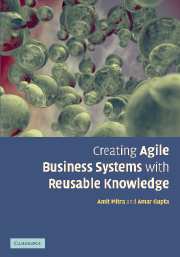Book contents
- Frontmatter
- Contents
- List of boxes
- List of figures
- List of tables
- Foreword
- Preface
- Acknowledgements
- Introduction
- 1 On the nature of reality and the nature of business
- 2 The object at the root of it all
- 3 The nature of attributes
- 4 Domains and their expression
- Appendix: Key shared components of knowledge
- Bibliography
- Index
Appendix: Key shared components of knowledge
Published online by Cambridge University Press: 11 September 2009
- Frontmatter
- Contents
- List of boxes
- List of figures
- List of tables
- Foreword
- Preface
- Acknowledgements
- Introduction
- 1 On the nature of reality and the nature of business
- 2 The object at the root of it all
- 3 The nature of attributes
- 4 Domains and their expression
- Appendix: Key shared components of knowledge
- Bibliography
- Index
Summary
Activity (and other) costs (Module V, section 3).
Aggregate object. A collection (Module V, section 2). A composition is a structured aggregate.
Array (Chapter 4, section 1).
Assemble. A polymorphism of process and the part of relationship (Module V, section 4). Assemble emerged from a process that made an item a part of an aggregate in step with the flow of time. Similarly disassembly cuts the relationship between an aggregate and its parts, so that the part does not remain a part of the aggregate after disassembly has occurred. Thus disassemble is also a process, but it is a polymorphism of the exclude relationship (near the top of figure 116). Polymorphisms of disassemble will tell us how an aggregate is picked apart – explosively, all at once, or in steps – perhaps even one item at a time.
Attribute. A kind of object property that is also a subtype of domain. It is a relationship between an object class and a subtype of a domain that consists of a single value at any given time (Chapter 3, section 2).
Beginning and ending moments of an event (both are subtypes of moment).
Borel object. A generalization of the concept of array, useful for categorization and segmentation of objects and state spaces – a power set of values, or an infinitely large power set of ranges (see Module V, section 1).
Bounds (Chapter 3, section 2).
Capacity. A kind of cardinality constraint (see Module V, section 1).
- Type
- Chapter
- Information
- Creating Agile Business Systems with Reusable Knowledge , pp. 327 - 353Publisher: Cambridge University PressPrint publication year: 2007



